VI. Analysis of the 2MASS Second Incremental Release Catalogs
7. Comparison to External Catalogs and Models
Stars Showing Relatively Large Discrepencies between the PSC and Truth Photometry
Some of the standards showed discrepencies between their magnitudes in the 2nd Incremental Data Release and their adopted standard values. These included the Persson standard BRI0021 and 4 secondary standards listed below. The secondary standards may be identified by their coordinates -- they are not the primary Persson standards.
Summary
| Star | RA | Dec | Problem | Reason | Concern | Status |
|---|---|---|---|---|---|---|
| BRI0021 | 6.102500000 | -1.972260000 | J bad | Smudge in Image | OK: Bad  2 2 | Keep as standard |
| S860D (1) | 185.458520000 | -0.010540000 | Ks bad | 2 + calibration? + calibration? | OK: only 2  | Keep as standard |
| S860D (2) | 185.468250000 | -0.141250000 | Ks bad | 2 + calibration? + calibration? | OK: only 2  | Keep as standard |
| OphN9b | 246.826430000 | -24.914810000 | J,H,Ks bad | Variable | OK: Variable | Remove as standard |
| S813D | 310.249660000 | -5.211750000 | J,H,Ks bad | Obvious double | OK: Bad  2 2 | Remove as standard |
Comments
BRI0021:
The reason for the erroneous magnitude is that there is
a faint J smudge in the data next to the star, as seen in the J and
Ks images, shown in Figures
1 and
2. One would expect such an artifact
(the cause of which is unknown) to throw off the photometry.
Indeed, the observed H and Ks magnitudes are in good agreement
(H: 11.081 vs "true" 11.079; Ks: 10.560 vs. 10.538),
but the J magnitude is too faint (J: 12.019 vs. 11.862). This is
clearly indicated in the database, where the J PSF
We note also that last year we looked at the ~1000 observations of
BRI0021 then avaiable and there was no obvious evidence of true
variability.
The M9.5 red dwarf BRI0021 has a bad J magnitude.
Ironically, the resulting erroneously red color coupled
with bookkeeping mistakes
led to it being observed at Keck, which resulting in the
discovery of a powerful flare in this supposedly magnetically
inactive object ("BRI0021-0214: Another Surprise at the Bottom of the Main
Sequence," Reid, I.N., Kirkpatrick, J.D., Gizis, J.E., & Liebert, J.
1999, ApJ, 527, L105)
 2 value
is 7.0 for J as opposed to 0.7 and 0.6 for H and Ks. Furthermore,
the J aperture value is 11.903, which is in reasonable agreement
with the "true" value.
2 value
is 7.0 for J as opposed to 0.7 and 0.6 for H and Ks. Furthermore,
the J aperture value is 11.903, which is in reasonable agreement
with the "true" value.
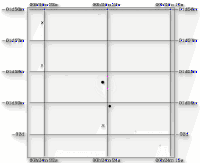
|
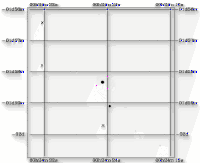
|
| Figure 1 | Figure 2 |
S860D secondaries:
The two S860D secondary standards, which have 0.1 mag discrepencies at
Ks, are in the same scan: 990124s scan 083. Both are
fairly faint (Ks=13.326 and and 13.288, respectively) and have
 of 0.049 and 0.044, which means that the
problem is at the 2- and 3-
of 0.049 and 0.044, which means that the
problem is at the 2- and 3- levels, respectively.
Curiously, in both cases the Ks aperture magnitudes are 1
levels, respectively.
Curiously, in both cases the Ks aperture magnitudes are 1
 closer to the "truth" (although the corresponding
H aperture magnitudes become bad by 1
closer to the "truth" (although the corresponding
H aperture magnitudes become bad by 1  ). The
image, shown in Figure 3, looks fine for
both.
). The
image, shown in Figure 3, looks fine for
both.
The behavior of nearby standards suggests that
Ks may be slightly off at this time, compared to the
nightly solution. That may be contributing 1  of the discrepancy.
of the discrepancy.
Thus, we suggest that we have successfully selected a
scan with faint
sources with a zero-point that is slightly off --
leading to a 2  event, which is not a big
surprise that these are encountered.
event, which is not a big
surprise that these are encountered.
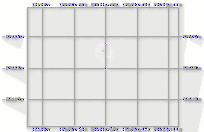
|
| Figure 3 |
OphN9b:
This secondary standard in the Ophn9b field
is too faint by 0.4 mag at J, 0.2 mag at H, and
0.2 mag at Ks. The aperture and PSF magnitudes agree,
and the  2 values are fine. Furthermore,
the J and Ks images, shown in Figures
4 and
5, look fine.
2 values are fine. Furthermore,
the J and Ks images, shown in Figures
4 and
5, look fine.
M. Skrutskie has found that this source is variable, as seen in Figure 6. Thus, it is not suitable as a standard star.

|
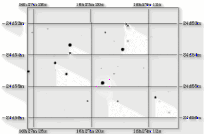
|

|
| Figure 4 | Figure 5 | Figure 6 |
S813D:
This secondary standard in the S813D field is obviously extended in the
images, as seen in Figure 7. Note that
other stars in the field do not look double.
It is therefore no surprise that the photometry is not good,
and in fact the aperture and PSF magnitudes wildly
differ and the PSF  2 values are 47, 23,
and 5.8 for J, H, and Ks, respectively! So, the Catalog values are
correctly marked.
2 values are 47, 23,
and 5.8 for J, H, and Ks, respectively! So, the Catalog values are
correctly marked.
We do not know why this source is extended. The fact it occurs in all three bands indicates it is NOT just due to a bad pixel. There is no known asteroid in the scan.
Further examination confirmed that this source is a double, and it was removed from the standard stars list.
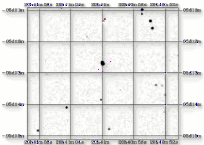
|
| Figure 7 |
Return to Section VI.7c.